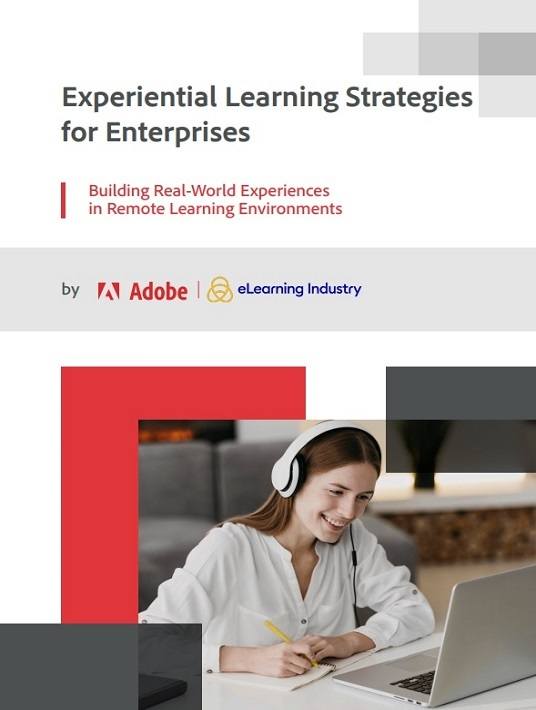Executing Experience Design In Your L&D Program
Experience design follows a generalized shift that calls for mindful and experiential consumerism instead of superficial and material. But how can you offer your customers meaningful experiences through your products and services? This article delves into the definition of experience design and then gives you a step-by-step guide on how to implement it using the most suitable tool.

eBook Release
Experiential Learning Strategies For Enterprises: Building Real-World Experiences In Remote Learning Environments
Discover how to execute experiential learning strategies for enterprises that enrich the experience and facilitate knowledge sharing.
What Is Experience Design?
Many businesses struggle to grasp the meaning of this term, and the reason is simple: experiences are hard to define. However, we can start making sense of it by viewing experiences as the way a customer feels in the moment that they are interacting with a product. In turn, we can define experience design as a customer-centric approach that offers products, services, and environments with features that focus on the user’s needs, feelings, and perspective. In the following section, we will guide you through the process of choosing the best virtual training software to help you achieve all your experience design goals.
7 Steps To Execute Experience Design
1. Lay Down Your Experience Design Objectives
This is the starting point of your Experiential Learning project. What are the experiences that you want to create? How do you want them to feel when using your training platform? These are some of the questions that will lead you to a solid plan of how you can design meaningful experiences that will captivate users and help them make the most out of training.
2. Determine Pain Points Among Learners
After laying out your overall objectives, it is a good idea to stop and listen to any feedback you already have. Usually, the road to change is laid out by the comments of your existing users as they search for ways to make training more interesting and more fitting to their evolving needs. Identify which aspects of training within your business are less than ideal and look for ways experience design can help you improve them.
3. Assess Your Current Tech
Embracing online training does not mean you have to start from scratch. The training material and technology you are already using may fit your Experience Design project. Therefore, take the time to carefully look through all the files, multimedia, scenarios, etc., that you have been using and figure out if they can be modified to promote the experience and not passive learning. In addition, if you are already using a Learning Management System, you could integrate it into your virtual training delivery software and combine features to create unique learning experiences.
4. Compare Virtual Training Software
At this point, you must have a clear understanding of your objectives, challenges, and available material. The next step is to find a virtual training delivery software to tie everything together. This is a great moment to tap into specialized online directories, social media groups, and industry acquaintances to find the best choices in the market. Compare features and read reviews to get an understanding of how each software enables experience design and elevates online training.
5. Prep Your Deployment Team
The people who will implement your Experiential Learning project are just as important as the software you are going to use. At this stage, you must assess the talents of your team in order to gauge the learning curve for your new software. If your development team needs to be trained to use it, choose the necessary training materials, and lay down an effective training plan. Finally, analyze possible risks of the implementation process and prepare solutions for each one. This way, you ensure the project’s success.
6. Create Or Cultivate Your Curriculum
Before launching your experience design project, make sure your curriculum is at par. Look for gaps between what you have already been offering and the captivating learning experiences you are planning for the future. This is also a great moment to decide on the type of training paths you want to design. Will it be structured training paths that are common for all learners? Or personalized training paths that each learner will slowly put together as they move through the training program? How will you measure each one?
7. Start Making The Most Of Your New Software
Finally, the last step to ensuring you are executing experience design in the best way possible is to get started immediately. Be quick to train your development team on your new virtual training delivery software and release a pilot virtual training program. This way, you can quickly establish the value of your investment and iron out any issues.
Conclusion
Experience design can be a challenging concept to get a hold of, especially if you do not have the right tools. However, the ways it will benefit your business are worth the initial effort. Hopefully, the guide we shared in this section has helped you understand which steps you need to take to execute experience design using the right virtual training software and give your learners captivating learning experiences.
Download the eBook Experiential Learning Strategies For Enterprises: Building Real-World Experiences In Remote Learning Environments today to launch programs that leave a lasting impression and maximize ROI.
Stay connected with us on social media platform for instant update click here to join our Twitter, & Facebook
We are now on Telegram. Click here to join our channel (@TechiUpdate) and stay updated with the latest Technology headlines.
For all the latest Education News Click Here
For the latest news and updates, follow us on Google News.
